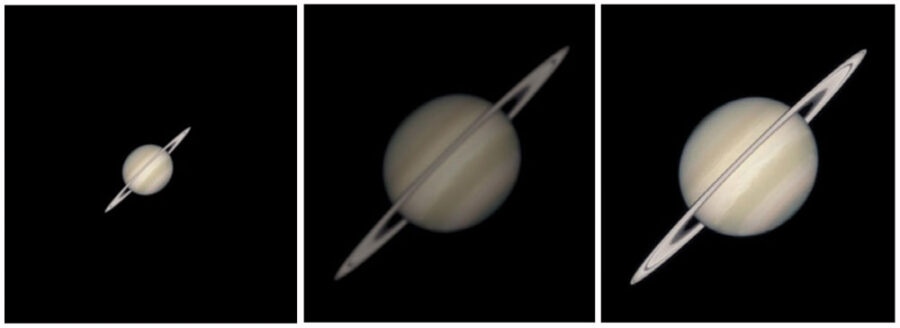Refractor telescopes use lenses and are ideal for wide-field observations, while Maksutov-Cassegrain telescopes use mirrors with a lens element for compact designs. Both have different optical systems and are suited for specific types of observations, with refractors providing sharp images but can suffer from chromatic aberration, and Maksutov-Cassegrains offering high contrast views and are more portable.
Understanding these differences can help you choose the right telescope for your stargazing needs, whether you prioritize portability, image quality, or versatility in observing various celestial objects. By comparing the features and capabilities of each type, you can make an informed decision and enhance your astronomy experience.

Credit: skyandtelescope.org
Refractor Telescopes
Refractor Telescopes: Unlocking the Secrets of the Universe
Design And Functionality
Refractor telescopes use lenses to gather and focus light, providing clear and crisp images.
Pros And Cons
- Pros: Ideal for planetary and lunar observations
- Cons: May suffer from chromatic aberration
Maksutov Cassegrain Telescopes
Maksutov Cassegrain telescopes, also known as Maksutovs, are popular among amateur and professional astronomers. The design features of Maksutov Cassegrain telescopes set them apart from other types.
Unique Design Features
Maksutov Cassegrain telescopes have a unique optical design that combines a thick meniscus corrector lens with a spherical primary mirror. This design results in a compact and portable telescope with a long focal length, making it ideal for planetary observation and astrophotography.
Advantages And Disadvantages
| Advantages | Disadvantages |
|---|---|
|
|
Optical Performance
When it comes to choosing between refractor and Maksutov Cassegrain telescopes, one of the most critical factors to consider is their optical performance. Understanding the differences in optical performance can help enthusiasts make an informed decision when investing in a telescope.
Resolution And Contrast
Resolution and contrast are significant aspects of optical performance. Refractor telescopes are known for delivering excellent resolution and contrast due to their unobstructed aperture. On the other hand, Maksutov Cassegrain telescopes also offer good resolution and contrast, thanks to their folded optical design that reduces the effects of diffraction and enhances image clarity.
Light Gathering Capacity
Refractor telescopes typically have larger apertures, allowing them to gather more light, which results in superior light gathering capacity. Conversely, Maksutov Cassegrain telescopes, with their compact and folded optical path, may have a smaller aperture, leading to slightly reduced light gathering capability compared to refractors.

Credit: skyandtelescope.org
Observational Versatility
Discover the distinctive features of refractor versus Maksutov Cassegrain telescopes. Refractors offer superior image quality, while Maksutov Cassegrains have compact designs for portability and versatility in observation. Both telescope types cater to different preferences and needs.
Astronomy Applications
Planetary Observation
Both refractor and Maksutov Cassegrain telescopes offer excellent capabilities for observing the planets in our solar system. Their high magnification power allows astronomers to see intricate details, such as the bands on Jupiter or the polar ice caps on Mars.
Deep-Sky Objects
For those interested in exploring deep-sky objects, both types of telescopes have their advantages. Refractors typically have larger apertures, which result in better light-gathering capacity, making them well-suited for capturing distant galaxies, nebulae, and star clusters. On the other hand, Maksutov Cassegrains have particularly long focal lengths which can enhance the clarity of these objects.
Photography
If you are looking to capture stunning images of celestial bodies, both refractors and Maksutov Cassegrain telescopes can meet your needs. Refractor telescopes are often preferred for astrophotography due to their superior color correction and minimal chromatic aberration. Maksutov Cassegrains, with their long focal lengths and compact design, are also excellent choices for capturing high-resolution images of planets.
Terrestrial Use
Landscape Observation
When it comes to terrestrial use, refractor telescopes have the upper hand. They are perfect for observing distant landscapes or wildlife with their wider field of view and shorter focal lengths. This versatility allows them to capture both the expansive beauty of nature and the details of smaller objects.
Compact Design
On the other hand, Maksutov Cassegrain telescopes are well-suited for terrestrial observing due to their compact design. Their closed-tube construction minimizes the effects of temperature fluctuations and makes them easily portable, ideal for landscapes or wildlife observation on the go. In conclusion, while both refractor and Maksutov Cassegrain telescopes offer their own unique advantages, their observational versatility shines in different areas. Whether you are an avid astronomer or a nature enthusiast, understanding the differences between these telescope types will help you choose the most appropriate one for your specific needs.
Practical Considerations
Considering practical aspects, the refractor and Maksutov-Cassegrain telescopes differ in size and portability. The refractor offers simplicity and versatility, while the Maksutov-Cassegrain design provides more compactness and higher magnification. These distinctions play crucial roles in meeting specific observational needs and preferences.
Choosing the right telescope involves taking into account various practical considerations. Portability and Setup as well as Maintenance and Durability are two important factors to consider when deciding between refractor and Maksutov-Cassegrain telescopes.
Portability And Setup
Portability plays a crucial role for those who wish to take their telescopes on the go. If you are someone who enjoys stargazing while traveling or attending star parties, a portable telescope is a must-have. When it comes to portability, refractor telescopes hold a significant advantage over Maksutov-Cassegrain telescopes.
- Refractor telescopes are generally lightweight and compact, making them easy to transport. They can be quickly set up and ready for observing in no time.
- Maksutov-Cassegrain telescopes, on the other hand, tend to be heavier and bulkier due to their optical design and larger aperture. They require more time and effort to set up properly.
If you often find yourself stargazing in remote locations or have limited storage space, a refractor telescope might be the more practical choice for you.
Maintenance And Durability
Maintenance and durability are key factors in ensuring the longevity and performance of your telescope. It is important to consider the level of maintenance required and the overall durability of each telescope type.
- Refractor telescopes are known for their simplicity in design, making them relatively low-maintenance. With their sealed optical tubes, they are less prone to dust and debris accumulation. Cleaning the lenses periodically and checking for any misalignment is usually sufficient for maintaining their performance.
- Maksutov-Cassegrain telescopes, on the other hand, have a more complex optical design with a corrector plate at the front. This plate may occasionally require cleaning. Additionally, their internal mirrors may need adjustment over time to ensure optimal performance.
- In terms of durability, refractor telescopes are generally robust and less prone to damage during transportation or accidental mishaps. The absence of movable internal components contributes to their durability.
- Maksutov-Cassegrain telescopes, due to their complex optical system and movable internal parts, may be more susceptible to damage or misalignment. Thus, they require more careful handling and storage.
Ultimately, considering the practical aspects of portability, setup, maintenance, and durability will help you choose the telescope that best fits your needs and observing habits.
Price And Value
When it comes to choosing between a refractor telescope and a Maksutov-Cassegrain telescope, understanding the price and value is crucial. Both types of telescopes offer unique benefits, and considering the initial investment and long-term benefits can help you make an informed decision.
Initial Investment
A refractor telescope may come with a lower initial investment compared to a Maksutov-Cassegrain telescope. However, it’s essential to consider the quality of optics and mount when evaluating the initial cost. Refractor telescopes are available in various price ranges, from affordable entry-level models to premium options. On the other hand, Maksutov-Cassegrain telescopes generally require a higher initial investment due to their intricate optical design and high-quality construction.
Long-term Benefits
While a refractor telescope may offer a lower initial investment, a Maksutov-Cassegrain telescope provides long-term benefits such as superior optical performance and versatility. Maksutov-Cassegrain telescopes are known for their compact design and excellent image quality, making them suitable for both celestial and terrestrial observations. Additionally, the durability and minimal maintenance required for Maksutov-Cassegrain telescopes contribute to their long-term value.
Making The Right Choice
Matching To User Needs
Refractor telescopes excel in visual clarity, perfect for beginners and lunar viewing.
Maksutov Cassegrain scopes are ideal for planetary observation, offering compact designs and portability.
Future Considerations
Consider your long-term interests when making your telescope choice.
Refractors are maintenance-free, while Maksutov Cassegrains may require periodic collimation adjustments.

Credit: www.amazon.com
Frequently Asked Questions
What Is The Main Difference Between Refractor And Maksutov Cassegrain Telescopes?
Refractor telescopes use lenses to gather and focus light, while Maksutov Cassegrain telescopes use mirrors. This difference impacts their design, performance, and price range. Refractors are excellent for viewing planets and bright objects, whereas Cassegrains are compact and great for astrophotography.
Which Type Of Telescope Is Better For Beginners, Refractor Or Maksutov Cassegrain?
For beginners, refractor telescopes are often recommended due to their simplicity and ease of use. They are also more affordable and require less maintenance compared to Maksutov Cassegrain telescopes. However, both types have their advantages and it ultimately depends on your specific needs and interests.
Can Maksutov Cassegrain Telescopes Be Used For Astrophotography?
Yes, Maksutov Cassegrain telescopes are well-suited for astrophotography. Their compact design, longer focal length, and ability to provide high magnification make them ideal for capturing detailed images of the moon, planets, and other celestial objects. However, they typically require additional accessories and equipment for the best results.
Conclusion
Refractor and Maksutov-Cassegrain telescopes each offer unique advantages for stargazing enthusiasts. Whether it’s the crisp images of a refractor or the portability of a Maksutov-Cassegrain, choosing the right telescope comes down to personal preferences and observing goals. Understanding these key differences can help you make an informed decision and enhance your astronomical experiences.



